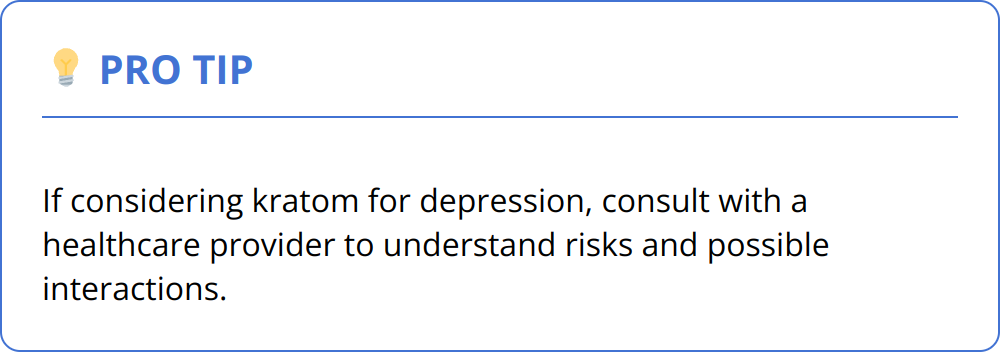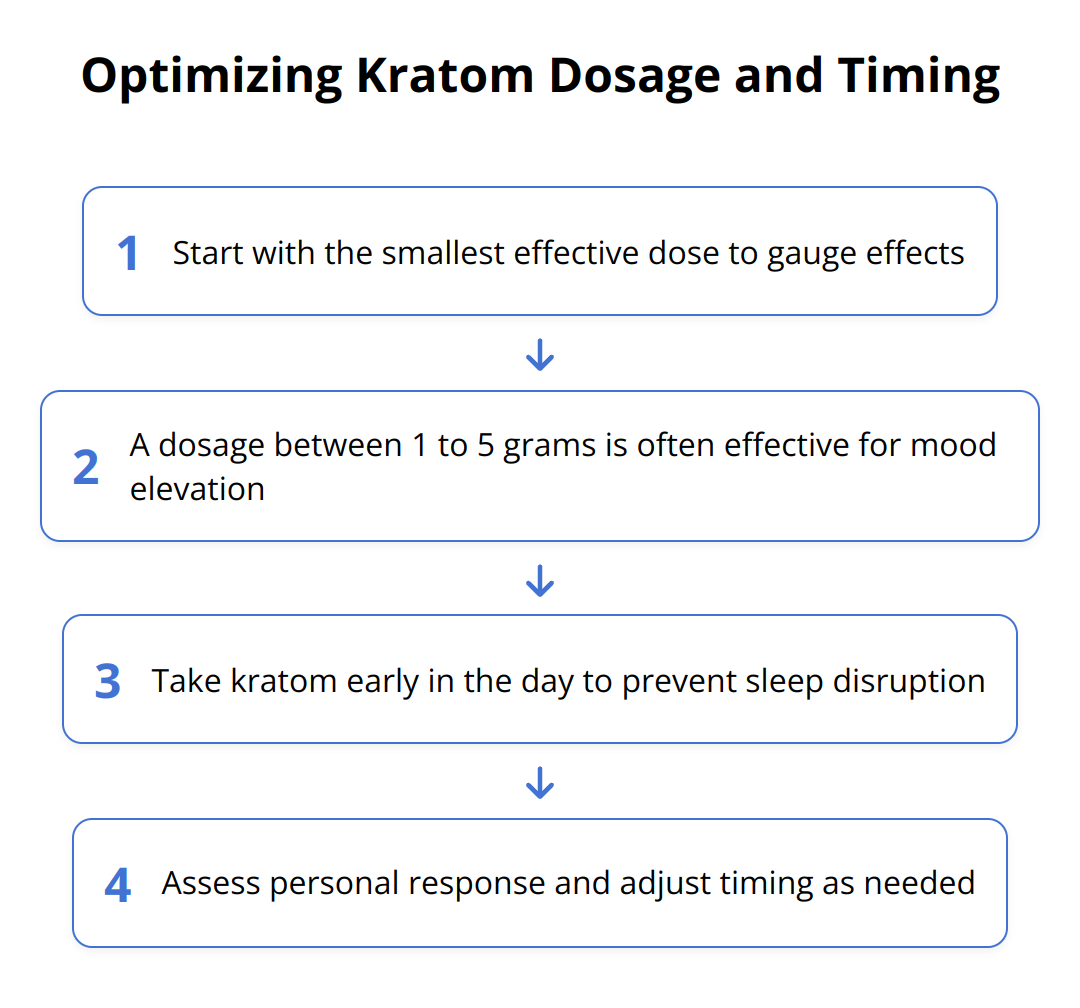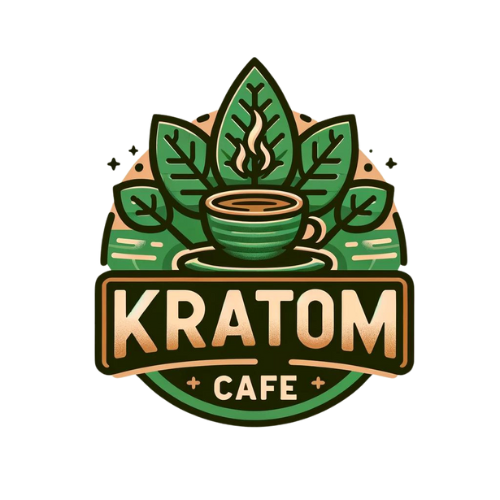At Kratom Cafe, we understand the complexities of mental health and the ongoing quest for alternative therapies. Kratom, with its unique profile of alkaloids, has captured the attention of many as a potential mood-enhancer.
In the following article, we’ll examine both anecdotal and research-backed perspectives on kratom’s effects on depression. We’ll also provide practical advice for those interested in exploring kratom as an adjunct to their mental wellness regimen.
Kratom’s Mood Elevating Qualities
Kratom, an evergreen plant hailing from Southeast Asia, has been traditionally utilized for its mentally stimulating and mood-lifting properties. Rich in compounds like mitragynine and 7-hydroxymitragynine, kratom has sparked significant interest for its potential to influence mood and mental health.
The powers of kratom reside predominantly in its alkaloids, which are the plant’s active ingredients known to bind with various receptors in the brain. The interaction with these receptors, inclusive of opioid, serotonin, and dopamine types, underpins the range of effects that kratom may exert on an individual’s mood.

It’s these attributes that lead users and researchers alike to investigate its antidepressant potential.
Drawing upon a wealth of anecdotal evidence, users often report a sense of enhanced well-being and reduced anxiety following kratom consumption. Academic studies reinforce these claims, pointing out that substances in kratom possibly exhibit antidepressant and antipsychotic effects.

However, it’s necessary to approach this plant with a measure of caution, as conclusions are yet to transition from being purely observational to firmly established. The body of research, while growing, is still nascent and requires more extensive studies for definitive answers.
For those considering incorporating kratom into their mental health maintenance routine, practical guidance is indispensable. Here are a few actionable tips:
-
Start Low, Go Slow: Begin with smaller doses of kratom to understand your body’s response.
-
Strain Selection: Choose strains reputed for their mood-lifting effects, such as Maeng Da or Green Malay.
-
Consistent Quality: Procure your kratom from reputable sources to ensure a contaminant-free product. Always ensure rigorous product testing, a practice that we, as a market leader, steadfastly uphold.
-
Listen to Your Body: Monitor both positive and negative reactions, adjusting usage accordingly.
-
Professional Advice: If you’re considering kratom for mood enhancement, especially alongside current treatments, engage with a healthcare professional beforehand.
While promising as a potential adjunct therapy for mood disorders, kratom is not a silver bullet. Every individual is unique and response to kratom can vary widely. We advocate informed and responsible usage, emphasizing the plant’s complementary role rather than a standalone solution. Empower yourself with knowledge, exercise patience, and be prepared to adapt. A thoughtful, measured approach is the key to integrating any new element into a holistic mental wellness strategy.
Kratom and Depression: What Do Users Say?
Exploring the realm of alternative therapies, the user testimonials on kratom’s mood-altering capabilities shine a bright light. People have turned to this plant as a potential source of relief from the crushing weight of depression, and their experiences are telling. While these stories provide a valuable dimension to kratom’s story, it’s critical to sift through these narratives with an analytical lens, looking for patterns and common experiences that might inform its use as an antidepressant.
In the online world, kratom forums and communities are abuzz with discussions about the plant’s ability to alleviate symptoms of depression. Numerous users speak to the uplift in spirits they feel, and the motivation that comes in tow when consuming low doses of particular strains. Just as caffeine kick-starts your morning, a small amount of kratom might spark a notable change in mood and perspective.
Yet it’s not all sunshine and rainbows; some users recount less positive experiences, with feelings of dependency or withdrawal after prolonged use. This reinforces our stance on responsible and informed use, paying close attention to one’s own responses and maintaining open communication with healthcare professionals.

Let’s highlight some recent findings that demonstrate kratom’s potential:
-
An online survey indicated that nearly 20.2% of kratom users consume it primarily to manage depression.
-
User demographics suggest a tilt towards females under 41 utilizing kratom for mental health, which is a notable trend.
On the research frontier, findings regarding kratom’s impact can be summed up as promising yet preliminary. Studies have hinted at kratom’s capacity to alleviate depressive symptoms, hypothesizing that its interaction with serotonin and dopamine receptors might emulate the effects of conventional antidepressants. Clinical trials are sparse, but the emerging data is encouraging as it points to potential antidepressant properties of kratom’s alkaloids.

While these studies offer a glimmer of hope, they also underline the need for rigorous scientific validation. Studies exploring the impact of kratom on neuronal oscillations, for instance, suggest changes that could have a positive influence on mood regulations. Yet without solid clinical evidence, it’s imperative that we treat these findings as directional rather than definitive.
In wrapping up, remember that self-medicating with kratom for depression is not endorsed by the medical community. It’s always safer to seek guidance rather than navigate these waters alone. Be vigilant about potential interactions if you’re taking other medications, and pay heed to changes in your mental health. Here’s a list of practical considerations:
-
Research thoroughly: Know the strains, doses, and potential interactions.
-
Use responsibly: Be attuned to the effects and avoid over-reliance.
-
Document experiences: Keep a log to track your response to different strains and dosages.
Finally, it bears repeating that the path to mental wellness is an intricate dance of variables, including lifestyle, genetics, environment, and biology. Kratom might play a role in this intricate dance for some, but it’s not a universal remedy. With more research, we may someday have a clearer understanding of where kratom fits in the tapestry of depression treatments. For now, it represents one piece of an extensive puzzle.
Optimizing Kratom for Mood Support
Kratom’s growing popularity as a mood-supporting supplement comes with an array of options and best practices to optimize its potential benefits. When considering kratom for mood elevation, thoughtful decision-making is imperative. Knowing how to choose the right strain, the correct dosage, and the best timing for intake can make a significant difference in the effectiveness of this natural supplement for mental health support.
Finding the Best Strain
Selecting the ideal kratom strain is a foundational step in enhancing mood. Strains like Maeng Da are lauded for their ability to increase energy and uplift mood, making them top choices for those looking to combat lethargy and despondency. Green Malay is another strain worth exploring for its balanced effects that may assist with focus while also having calming properties. It’s important to consider individual responses to each strain, as what works for one person may not work for another. Testing different strains to measure their impact on mood can help to tailor a personal kratom regimen.
Dosage and Timing Insights
Understanding dosage is pivotal. Kratom’s effects largely depend on how much is consumed — smaller doses tend to produce stimulating effects while larger doses might induce relaxation. Initiate with the smallest effective dose and evaluate the results. Many users find a dosage between 1 to 5 grams to be their sweet spot for mood elevation. As for timing, kratom can be particularly beneficial when taken early in the day or at moments when mood support is most needed, though it’s wise to avoid late evening doses that might interfere with sleep.

Sustaining Benefits Over Time
For long-term management, sustainability is key. Regular use can lead to tolerance, reducing kratom’s efficacy. To prevent tolerance build-up, avoid daily consumption and consider cycling strains. It’s equally vital to watch for signs of dependence and to take breaks from kratom to mitigate withdrawal symptoms. Knowing when and if to discontinue use is essential for maintaining kratom as a sustainable part of a broader mental health strategy.
Here are a few practical tips:
-
Evaluate different strains for mood support, starting with Maeng Da and Green Malay
-
Find your minimum effective dose, typically between 1 to 5 grams
-
Use kratom early to avoid sleep disruption
-
Take breaks to manage tolerance and dependence
-
Consult healthcare professionals when integrating kratom with other treatments
Keep in mind that these insights are based on user experiences and available research. Always exercise caution and consult healthcare professionals before beginning any new supplement for mental health purposes. Additionally, keep abreast of the legal status of kratom in your location, as it varies by country and state.
Overall, kratom may offer a complementary approach when tackling the symptoms of depression. However, it requires a responsible, individualized, and informed strategy to maximize its potential benefits while mitigating risks.
Wrapping Up
As we reflect on the information presented, it becomes evident that kratom’s potential in addressing depression has captured the interest of many. The alkaloids found within kratom, particularly mitragynine, offer promising avenues for mood elevation and mental health support. Reports from individuals using kratom suggest that it may indeed have a positive impact on depressive symptoms, citing experiences of enhanced well-being and a boost in motivation.
![Key Takeaways - Kratom Antidepressant Effects [Pro Tips]](https://kratomcafe.com/wp-content/uploads/2024/02/Kratom-Antidepressant-Effects-Pro-Tips-6-2024-02-16-070836.8245280000.png)
It’s imperative, however, to underscore the importance of continued research. The current understanding of kratom’s efficacy and safety is rooted in a combination of user testimonials and emerging scientific studies. To fully grasp the extent of its antidepressant-like qualities, more rigorous, controlled clinical research is essential.
Kratom Cafe is committed to guiding individuals through the intricate landscape of kratom use for mental health. We emphasize the significance of responsible use, which includes acknowledging the need for moderation, understanding potential risks, and recognizing individual variability in response to this plant. The factors that contribute to mental wellness are deeply personal and nuanced, and thus, so should be the approach to using kratom.
For those interested in exploring kratom as a part of their mental health journey, we encourage:
-
Personal research to comprehend the intricacies of this botanical
-
Mindful usage to maintain control over one’s wellbeing
-
Dialogue with healthcare providers to safely integrate kratom into one’s routine
In conclusion, while kratom represents a beacon of hope for some, it is not a universal remedy for depression. At Kratom Cafe, we invite you to remain open to new knowledge, to approach kratom with both curiosity and caution, and to make well-informed decisions. Visit our information hub to stay updated on the latest developments in kratom and mental health.
The road to mental health is seldom straightforward. As kratom continues to be studied and its effects become clearer, it may emerge as a valuable complement in the management of depression. Until then, we advocate for an approach that balances optimism with pragmatism, one that prioritizes safety and personal well-being above all.

